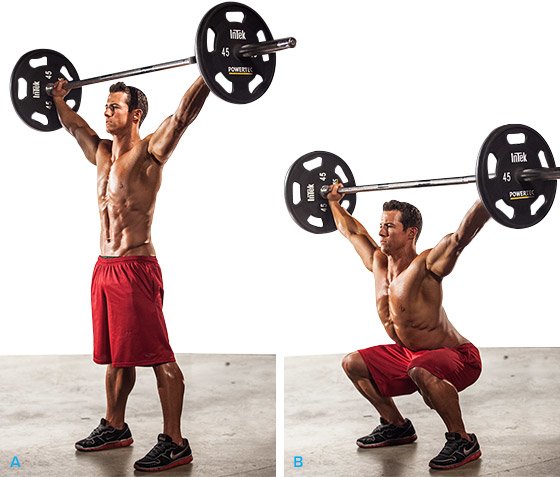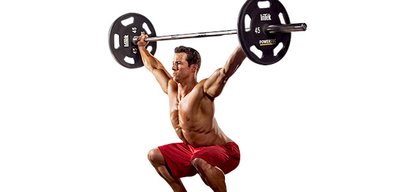The overhead squat has gotten some good press lately because of CrossFit. It's easy to like doing the overhead squat because A) it's hard and B) it looks cool. However, throwing it into your regimen just because you want to look like a badass is probably a bad call.
If you find yourself at the bottom of an overhead squat and suddenly wonder, "Why the hell am I doing this?" you're asking yourself a really good question.
The overhead squat should, first and foremost, be used as a mobility-training device. The strength carryover it has to other lifts like the snatch, back squat, front squat, and overhead press is negligible. So, if you're doing them to make your legs stronger, they won't work like you think they will.
However, the overhead squat is a great tool for training the strength and stability of your shoulders and core. It's also a great tool to mobilize your thoracic spine, ankles, and hips, and will help you feel more comfortable at the very bottom of a squat, front squat, or snatch.
Mobility, Stability, and Strength
Most people struggle with at least one of these mobility and stability issues:
- Tight, overlifted pecs that pull the shoulders and upper back forward.
- A rigid thoracic spine that can't extend.
- A weak core.
- Inflexible hips, knees, and ankles.
Doing overhead squats can actually help relieve these issues. It's important, though, that you start with basic positioning. Don't throw plates on a bar and expect your body to be able to handle it, especially if you have any of the above issues.
The overhead squat can turn you into a more limber, well-rounded athlete:
Extension Training
Most people sit hunched forward all day, then go into the gym and train their mirror muscles. If your torso is in constant flexion, your shoulders and scapulae are pulled forward, making it damn near impossible for your shoulders to be comfortable and strong when your arms are behind your head.
The overhead squat can help your body learn how to extend. Your thoracic spine and abdominal muscles must learn how to move backward with as much ease as they flex forward. If your thoracic spine and core can be strong and in a good position no matter what you're doing, you'll have better success in all of your lifts.

{{caption}}
Overhead Squat
Although it might be painful at first, putting your upper body into an extended position can improve the health of your spine and shoulders. As anyone who lifts knows, avoiding back and shoulder injuries is paramount. If you make your upper body lithe and agile, you may feel less pain throughout the day as well.
Be warned, however, that you don't want to hyperextend your lower back when doing overhead squats. This can place strain on your back and may result in injury.
Hip And Ankle Mobility
If you struggle to do a back squat without your knees caving in or your heels coming off the ground, doing an overhead squat will make these issues even more apparent.
Most people lack the proper glute strength and hip mobility to make their posterior chain work efficiently. If you want to do an overhead squat, your calves, hamstrings, glutes, adductors, and lower back will need to pitch in to move the weight. Lean too far forward and you'll put strain on your knees and rely too heavily on your quadriceps.
If your knees continue to collapse inward, focus on loading your glutes and hamstrings. Your knees should never fall inside of your toes. Learning how to consciously move your knees into the right position will make your squat better and your jump movements safer.
Having the ability to sit with your hips between your knees and your back in an extended (but not hyperextended) position is also really healthy for your hips.
The overhead squat is also a great indicator of ankle flexibility. If you can't get more than 90 degrees out of your dorsi-flexed ankle—meaning toes pointed toward your face—you need some work.
Core Strength Training
Your abdominals, obliques, and deep core muscles such as the transverse abdominis are essential to squats, pull-ups, and almost every other exercise you can name.
Although many of us train abs by doing endless crunches, the primary role of the core is antiextension and antiflexion. So, if you have a loaded barbell on your back, your core must keep you from falling forward or backward and getting crushed.
The overhead squat makes your core work overtime because the weight is over your head, making your center of gravity much higher. Also, because your torso is elongated, the tension in your deep inner-core muscles will be very intense.
Shoulder Stability Training
If you've ever put something heavy over your head, you know how wobbly it can feel. When you're lifting, the last thing you want to feel is unstable.
Including the overhead squat in your program can train your shoulders to function better. To do the exercise properly, you'll have to be able to rotate your shoulders and retract your scapulae. That's not an easy position, even at a light weight.
Always remember that your shoulders need to be above your head without you having to hyperextend your spine or shove your chest forward. If you can train your shoulders to stay in a stacked, tight position when there's weight over your head, they're much more likely to stay injury-free later in life.
Balancing Act
Holding a load aloft while you squat requires balance. The weight needs to be perfectly placed above the center of gravity. If you lean too far back on your heels, you risk losing the weight behind you. If, on the other hand, you're on the balls of your feet with your heels in the air, there's a good chance you'll miss the lift forward.

{{caption}}
Learning how to balance is a really good life skill. So, even if you aren't going to be doing an overhead squat in "real life," having the body awareness to recognize when you're off balance and in a compromised position will help you.
A Note of Caution
The overhead squat is a really difficult movement to do correctly. To do it wrong is to do yourself a disservice. So, before you get under a loaded barbell, do this drill.
To start, stand with your back against a wall and your feet about 6 to 10 inches forward. Put your hands over your head with your shoulders against the wall. Keep your hands over your head and your shoulders against the wall as you squat down. If you need to, grab a hand towel and stretch it out between your hands.
If you can do this without your shoulders coming off the wall or your knees collapsing in, then you can try doing it without the wall for support. With only your body to rely on, you'll have to trust your core to keep you upright.
Grasp the towel over your head and squat down. Your heels should be on the ground; your butt should be back; and your shoulders and upper back should be straight up and down, not flexed forward. Your knees should be pushed out and your glutes should be activated.
Sit in this position. Move your knees in and out. Play with your grip on the towel. Notice how your body feels. If you can maintain an upright torso with your shoulders rotated and retracted, your heels on the ground, your knees pushed out, and your lower spine in a neutral position, then try the lift with a barbell. The barbell may actually make the lift feel easier because the weight will help you balance.
If you get good at doing the overhead squat with a loaded barbell, it's time to challenge your mobility. Move your hands closer together so your wrists, elbows, and shoulders are stacked on top of each other. This might be a more difficult position for you at first, but it will end up being much more stable.

